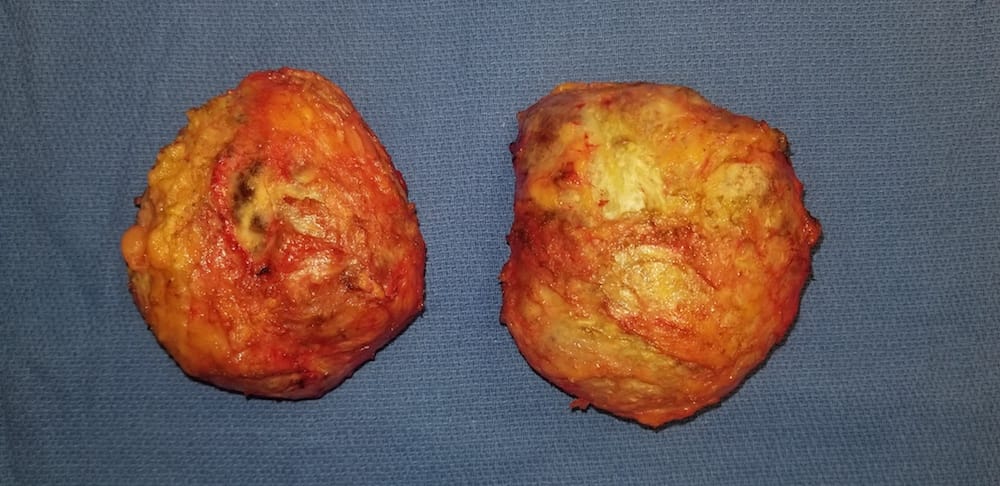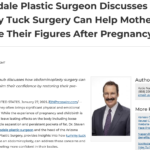Quick Facts About Breast Implant Removal
- Principle Benefits: Breast implant removal can help eliminate concerns related to implants—such as capsular contracture, rupture or shifting—while restoring natural breast contours.
- Treatment Overview: The procedure involves the surgical removal of the breast implants. This is most often performed under general anesthesia though in some situations it can be done just using local anesthesia. When done as the sole procedure, surgical time is typically 1.5 hours or less. When combined with other procedures such as a capsulectomy or breast lift, surgical times will be substantially longer.
- Recovery Timeline: Patients generally return to light activities within a few days. More vigorous activities will typically need to be avoided for at least 3-4 weeks to help maximize the likelihood of an optimal recovery.
- Average Cost: According to patient data from RealSelf, the average cost of implant removal in the Phoenix metropolitan area is $12,863. However, this number is quite misleading with the true costs for a straightforward explantation typically being significantly lower. After a consultation with Dr. Turkeltaub, a personalized price quote can be provided based on the details of your specific case.
Although breast augmentation has among the highest rates of patient satisfaction of all cosmetic procedures, some women decide later on in time that they no longer want to have their breast implants. This is true for women who have had their implants placed either for aesthetic or reconstructive purposes. There are a variety of reasons behind this increasingly popular procedure.
Breast implant removal, also known as explantation, is a surgical procedure that involves the permanent removal of breast implants and any surrounding scar tissue (capsulectomy), if necessary or requested. This can be performed in conjunction with another breast procedure such as a mastopexy or even a breast reduction.
Board-certified plastic surgeon Steven Turkeltaub, MD is highly skilled and experienced in performing explantation surgery for those women desiring the procedure for whatever reason. Based on your unique needs and aesthetic preferences, he can tailor a treatment plan to help you achieve an optimal breast appearance through the safest, most effective means possible.
The following sections should provide you with useful as well as interesting information about breast implant removal. Of course, to receive the most personal and helpful information and recommendations regarding your specific situation, you can contact our practice to schedule a private consultation with Dr. Turkeltaub.
- What Are Some Common Reasons for Breast Implant Removal?
- What Are BIA-ALCL and BII?
- What Does the Breast Implant Removal Procedure Entail?
- Will I Need a Breast Lift After Implant Removal?
- What Is En Bloc Capsulectomy?
- What Is Recovery from Breast Implant Removal Like?
- What Do Breasts Look Like After Implant Removal?
- How Much Does Breast Implant Removal Cost?
- Breast Implant Removal Before-and-After Photos
What Are Some Common Reasons for Breast Implant Removal?
Breast implant removal is performed for a wide array of reasons with some of the most common motivations being:
- Lifestyle changes. For physical, social, personal or other reasons, some women decide that they just want smaller breasts now. Removing their implants will accomplish this.
- Implant related issues. Whether it is capsular contracture, rupture, rippling or another implant related issue, some women decide that they no longer need implants or want to deal with any potential future problems that can be associated with them so now is the perfect time for their explantation.
- Breasts are far too large due to substantial weight gain. Following their breast augmentation, many women do gain a significant amount of weight over the years. This frequently adds a lot of volume and weight to the breasts, making them overly large and sometimes even causing neck, shoulder and back discomfort. Permanently removing the implants can address at least part of this issue.
- Changed cultural tastes. No longer are substantial or over-enlarged breasts considered to be desirous or even extremely attractive by many. Now, the look is natural, small or nothing whatsoever. Therefore, when some women are faced with implant related issues, instead of replacing them even with a smaller size, they decide to just to have them removed permanently.
- Financial. Some women find that the prospects of future costs related to breast implants outweigh the benefits of having them. Consequently, when they are faced with having to deal with an implant issue such as rupture, they just decide to have them removed rather than having them replaced with new ones.
- Health related concerns. Whether real or imagined, some women decide that their implants are causing or possibly could cause health related issues in the future so they request an explantation. (See below: “What Are BIA-ALCL and BII?”) There are other women who have made the decision that they no longer want something foreign in their bodies.
Ultimately, the decision to pursue explantation is unique to every individual and may even include factors that are not listed above. Whatever your specific motivation(s) for breast implant removal might be, Dr. Turkeltaub is happy to help you achieve the look you desire for your breasts.
What Are BIA-ALCL and BII?
BIA-ALCL and BII are acronyms that respectively stand for breast implant-associated anaplastic large cell lymphoma and breast implant illness.
Not to be confused with breast cancer, BIA-ALCL is a rare* form of non-Hodgkin’s lymphoma that can develop within the scar capsule surrounding certain types of breast implants. Symptoms typically include pain, lumps in the breast and/or armpit, breast enlargement and/or asymmetry, skin rashes, breast hardening or fluid accumulation well after implant placement. Currently, research has linked BIA-ALCL exclusively to textured-surfaced implants—most notably Allergan® textured implants which were recalled worldwide in July of 2019.
When identified and diagnosed early, BIA-ALCL has shown to be highly curable in most cases through explantation and full capsule removal. Due to the low incidence of BIA-ALCL, the U.S. Food and Drug Administration (FDA) advises that women with textured breast implants do not need to have them removed for preventative purposes at this time if they are not experiencing any symptoms, though explantation and capsulectomy with or without the placement of new implants is certainly an option for anyone who wishes to be ultra-conservative.
BII, or breast implant illness, refers to a variety of adverse systemic reactions that some women believe are related to their breast implants. A few of the most common symptoms and complaints include chest discomfort, persistent fatigue, chronic headaches, hair loss, chills, sensitivity to light, anxiety, brain fog and more. Unlike BIA-ALCL, there is currently no scientific evidence that directly links BII to breast implants despite extensive research; however, Dr. Turkeltaub takes all unfavorable responses to breast implants very seriously and will work diligently to resolve the issue(s) for anyone experiencing negative reactions. In some cases, the resolution of symptoms may require breast implant removal.
*As of January 4th, 2021, the American Society of Plastic Surgeons (ASPS) estimates the lifetime risk of developing BIA-ALCL for women who have textured implants is between 1:2,207 and 1:86,029. There are 355 both suspected and confirmed cases in the United States, and 993 worldwide.
What Does the Breast Implant Removal Procedure Entail?
There are several different techniques that can be utilized to perform an explantation. Dr. Turkeltaub will select the approach that can achieve the best outcome while minimizing the risk of any complications. In some instances, only the breast implants will need to be removed, though if capsular contracture or other capsular issues are present a partial, subtotal or total capsulectomy is performed. The surgical method often employed for a total capsulectomy is the en bloc technique, when possible, which is further explained in the next section.
The amount of time it takes to perform a breast implant removal procedure will depend on a variety of factors that can include whether or not a capsulectomy is performed, the extent of it when done, the nature of the capsule itself, whether the implants to be removed are ruptured and whether a concurrent procedure like a breast lift or breast reduction is performed.
Will I Need a Breast Lift After Implant Removal?
Deciding whether you need a breast lift after implant removal depends on several factors such as skin elasticity, breast size before and after implants, implant size, implant size relative to the overall breast size and personal aesthetic goals. After implant removal, your breasts may appear deflated and saggy due to the stretched skin and tissue. A breast lift (mastopexy) can help restore a more youthful and lifted appearance by removing excess skin and reshaping the breast tissue.
Consulting with a board-certified plastic surgeon like Dr. Turkeltaub is essential to evaluate your specific situation and determine if a breast lift is necessary in order to achieve your desired outcome.
What Is En Bloc Capsulectomy?
A total capsulectomy is the complete removal of the capsule (scar tissue) that forms around the breast implant. It can be accomplished by sequentially taking out pieces until the entire capsule is removed or by removing it along with the implant as a unit. The en bloc capsulectomy is the technique of removal of the entire capsule along with the contained breast implant as an intact unit.
The en bloc capsulectomy is the technique of removal of the entire capsule along with the contained breast implant as an intact unit.
There are situations where the en bloc removal would be more desirable, if possible, and then there are patients who insist on this technique for a variety of reasons including based on social media postings. Many patients who request this procedure have extremely thin, soft and sheer like capsules making this technique impossible to perform. Dr. Turkeltaub does perform en bloc capsulectomies when indicated or requested (if possible).

The images above show bilateral capsulectomies with explantation using the en bloc technique.
What Is Recovery from Breast Implant Removal Like?
Following breast implant removal, a comfortable but compressive dressing is placed. This is removed in a few days and replaced with a sports-type bra that is worn day and night for one to two weeks. After this period, Dr. Turkeltaub recommends wearing a supportive bra on a regular basis which will also help reduce the undesirable effects of gravity.
You may experience mild to moderate discomfort initially after explantation but this usually resolves quickly so that you are able to resume non-strenuous daily routines and office-based work within a few days to one week. In order to promote proper healing and optimal results with minimization of risk, any vigorous activities like aerobic exercise or contact sports will need to be avoided for at least three to four weeks.
What Do Breasts Look Like After Implant Removal?
The appearance of your breasts following implant removal depends on a variety of factors, some which were stated previously. These include the elasticity of your skin, thinness of your skin, breast size before and after implants, implant size, implant size relative to the overall breast size, the presence of an implant rupture and the period of time that you have had breast implants. The breasts may appear deflated, saggy and uneven with contour irregularities after implant removal due to the stretched skin, tissue changes and scarring.
Enhancing aesthetics post-removal can involve several options such as a breast lift or breast reduction. Based on your particular situation and if indicated, Dr. Turkeltaub can help tailor a plan to help you achieve a more desirable, improved breast contour that aligns better with your preferences and body proportions.
How Much Does Breast Implant Removal Cost?
The average cost of breast implant removal in the Phoenix area is $12,863 (a misleading number), as reported by actual patients on RealSelf.com. The national average ranged anywhere between $2,000 and $19,000, depending on factors such as geographic region, hospital and anesthesia fees and more. The final cost of treatment will also be influenced by whether or not additional procedures—such as a breast lift or reduction—are to be performed alongside the implant removal.
Following a personal consultation with Dr. Turkeltaub, our team can provide you with a custom price quote so that you can feel empowered and informed while making your decision.
Breast Implant Removal Before-and-After Photos*
Due to social media policies, the following images have been censored. Please click on the button below to view the image.
*Individual Results May Vary
Interested in Breast Implant Removal?
If you are considering breast implant removal and would like to speak with a board-certified plastic surgeon to discuss your options, please feel free to contact our practice to schedule a consultation with Dr. Turkeltaub.









